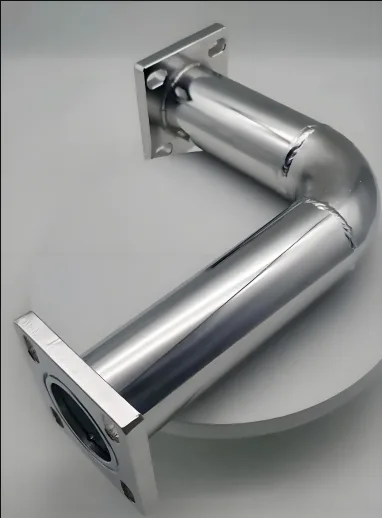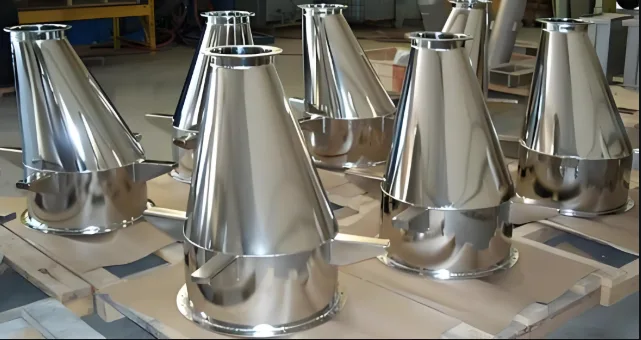Metal surface polishing, also known as metal surface leveling technology, is a crucial process. It significantly improves the flatness, finish, and overall appearance of various metal products, including copper alloys, stainless steel, and especially aluminum alloys. For aluminum, which has lower hardness and is prone to damage, polishing is essential. It helps achieve a bright, mirror-like surface, eliminates defects, and ultimately enhances product performance. Currently, we categorize metal polishing into three main types: mechanical polishing, electrolytic polishing, and chemical polishing.

Aluminum Alloy Surface Polishing Methods
Mechanical Polishing
Mechanical polishing uses high-speed rotating polishing wheels and grinding stones to abrade an aluminum product’s surface. This process involves metal slippage, which forms an amorphous layer. This layer then reduces surface roughness and increases brightness. We typically use this method for the rough treatment of aluminum materials. It effectively removes surface defects like oil stains, oxide scales, and burrs. However, mechanical polishing demands significant investment and complex equipment. It isn’t suitable for precision or intricate workpieces, and it offers poorer corrosion resistance and gloss durability after treatment.
Electrolytic Polishing
Electrolytic polishing, also called electrochemical polishing, processes aluminum alloy surfaces using an electrolyte and a DC power supply. It works by creating a current density difference that selectively dissolves surface protrusions, ultimately leveling the surface. Traditional electrolytes contained chromic acid, which caused significant pollution. Fortunately, new chromic acid-free electrolytes have emerged, effectively solving this environmental concern. Despite this, electrolytic polishing equipment is complex, often requiring specialized fixtures, and its high cost limits its widespread application.
Chemical Polishing
Chemical polishing is a surface treatment that uses chemical solvents to selectively dissolve the raised areas of an aluminum alloy surface, achieving a bright, mirror-like finish. This process is particularly vital for the surface finishing of aluminum products. Chemical polishing is widely used in the aluminum industry because it requires simple equipment, saves energy, and has low costs. It also excels at polishing complex-shaped workpieces. Chemically polished aluminum products boast excellent decorative effects, smooth surfaces, high heat and light reflectivity, and enhanced corrosion resistance.

Chemical Polishing Classification
In industrial applications, we primarily divide chemical polishing into acid chemical polishing and alkaline chemical polishing. Acid polishing further subdivides into traditional three-acid, modified three-acid, and two-acid chemical polishing.
Acid Chemical Polishing
Traditional Three-Acid Chemical Polishing
We prepare traditional three-acid chemical polishing liquid by mixing concentrated nitric acid, concentrated phosphoric acid, and concentrated sulfuric acid in specific proportions. This method is widely used in industry because it has simple equipment, is easy to operate, and costs little. It can also achieve a mirror reflectivity of 95%-97%. However, its main drawback is the highly toxic “yellow smoke” (nitrogen oxides) produced by nitric acid. This seriously harms human health and pollutes the environment.
Modified Three-Acid Polishing
To address the harmful nitrogen oxide gases from traditional three-acid polishing, the industry has improved the process in three ways:
Reducing nitric acid concentration: While this helps reduce yellow smoke, it can slow polishing and lead to poor surface brightness. It also doesn’t eliminate nitrogen oxide pollution.
NOx gas absorption and purification: This involves using activated carbon (dry absorption) or absorption towers (wet absorption) to purify the gases. Activated carbon has limited capacity and requires frequent, complex regeneration. Wet absorption effectively captures NOx but presents secondary pollution risks with liquid waste treatment and higher costs.
NOx gas conversion and inhibition: This method adds specific substances (like urea or aminosulfonic acid compounds) to the polishing liquid to inhibit or convert NOx into non-toxic gases. While it reduces yellow smoke, some additives can react with the polishing liquid, forming solids that stick to the workpiece, causing spots and reducing polishing quality.
These modifications have reduced pollution to some extent, but each still faces its challenges and limitations.
Two-Acid Polishing
Since the nitric acid in traditional three-acid polishing produces highly toxic nitrogen oxides (“yellow smoke”), researchers developed a “two-acid polishing” process. This method uses additives to replace nitric acid, aiming to eliminate pollution. While the two-acid system solves the yellow smoke problem, it lacks nitric acid’s passivation effect. This can lead to excessive corrosion and reduced brightness on the aluminum surface. Therefore, the additives are crucial; they must compensate for these deficiencies and ensure a good polishing effect. This process also demands more precise control of polishing time and temperature.
Alkaline Chemical Polishing Process
Alkaline chemical polishing processes aluminum products using a mixture of sodium hydroxide and additives. It relies on aluminum’s selective dissolution characteristics in alkaline solutions. During polishing, a large amount of sodium metaaluminate forms and accumulates in the surface’s concave areas. This creates a shielding layer. This shield hinders the polishing liquid’s diffusion into the depressions, slowing their dissolution. Protruding parts have greater contact with the polishing liquid and accumulate less sodium metasilicate, causing them to react more intensely than the concave parts. As microscopic unevenness decreases, reaction speeds become more uniform. This results in a relatively flat surface. The release, rise, and agitation of numerous microbubbles during polishing also enhance the erosion of microscopic protrusions, ultimately smoothing the aluminum surface. However, strong alkalis are highly corrosive to aluminum. This method yields a slower shine, lower gloss, and is prone to mottling. Overall, its polishing effect is not as good as acid chemical polishing.
Conclusion
Mechanical, electrolytic, and chemical polishing are all metal surface treatment technologies. They can effectively eliminate metal defects. Mechanical polishing is best for the rough treatment of aluminum products. In contrast, electrolytic and chemical polishing are more suitable for fine finishing. We can use them independently or combine them with mechanical polishing (applied after mechanical polishing).
